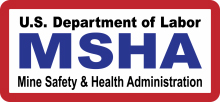An inside look at MSHA’s rulemaking
 A few weeks before the new workplace examination rule was slated to go into effect, the Mine Safety & Health Administration (MSHA) finally opened a proposed rulemaking.
A few weeks before the new workplace examination rule was slated to go into effect, the Mine Safety & Health Administration (MSHA) finally opened a proposed rulemaking.
Mine operators expected this proposal to roll back the most burdensome and impractical aspects of the new final rule. Unfortunately, MSHA’s proposal falls far short of what is needed to give the industry and miners a rule that is workable and delivers meaningful safety improvements.
Many are asking: Why didn’t MSHA make more changes to the rule? The already-existing rulemaking record clearly supports that.
President Trump’s directive for reduced regulation supports that, too. How did we get to this point where we are still having to contend with burdensome new requirements for workplace examinations?
The answer lies in the fundamentals of MSHA rulemaking – the “when, why and how” regarding MSHA’s decision to change a final rule.
The when
Politics often influences the timing of a decision by MSHA to modify an existing safety standard. That certainly is the case here. The original workplace examination rule had long been in effect. MSHA tried at least twice to change the rule by taking a shortcut. Rather than engaging in notice and comment rulemaking, in which all stakeholders could participate, MSHA instead issued enforcement guidance on its own.
One of the key items the agency tried to add was the requirement that workplace examiners record on the examination form any potentially hazardous condition found. The rule plainly did not require that.
When the industry called out MSHA for this, the agency retreated and restored the original interpretation of the rule. This set the stage for the Obama administration’s rulemaking in the latter half of 2016 into early 2017.
The current final rule on workplace exams was hastily developed in the final months of the administration. One of the items added is this same requirement that the person doing the exam record safety conditions found.
Other things were added, too, including requiring the examination to be completed prior to work beginning in a working place (rather than at any time during the shift); providing prompt notification to miners of conditions found in places where they will be working; and recording on the exam record the date that corrective action was completed for each condition found.
This final rule was promulgated at the last minute before the change in administrations. Clearly, this is not a rule that the Trump administration would have promulgated. That brings us to the next question: Why does MSHA decide to change a new final rule that hasn’t even yet gone into effect?
The why
With respect to the workplace examination rule, the answer to this question is obvious: MSHA changed its mind. The agency under the Obama administration repeatedly expanded its standards, leading to broader enforcement mandates. The agency under the Trump administration may be just beginning to make the expected shift toward a different approach.
Sometimes, MSHA changes an existing rule to alter the rule’s impact, and sometimes MSHA changes a rule to address updates in technology and mining. Often, as we see here, the changes are driven by a shift in agency enforcement focus.
The how
We now come to what is the most critical question for where we are today in the rulemaking. The administration’s focus on reduced regulations has caused MSHA to reconsider its new final rule. Having seen now what little MSHA is proposing to change, mine operators are asking why doesn’t the proposal better address our concerns.
The answer likely is twofold. First, as of the date of this new proposal from MSHA, the agency was still awaiting appointment of its new assistant secretary. Consequently, there may be limitations on how far the agency is willing to go at this time in rolling back the final rule.
Second, MSHA is operating under restrictions imposed in the Federal Mine Safety & Health Act. The law that provides MSHA the authority to issue safety and health standards limits MSHA’s authority in a critical way for the situation at hand. MSHA cannot revoke or revise an existing mandatory standard in a way that would reduce miner health and safety.
Bill Doran and Margo Lopez are with the national labor, employment and safety law firm Ogletree Deakins. They can be reacched at william.doran@ogletree.com and margaret.lopez@ogletree.com.









